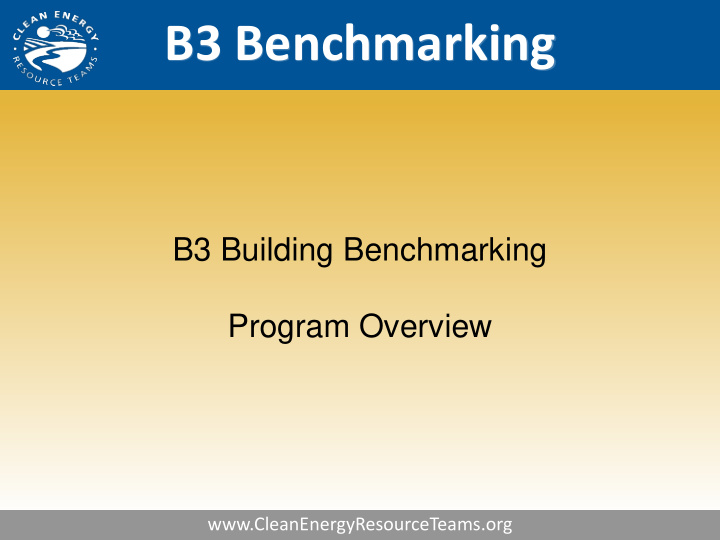



B3 Benchmarking B3 Building Benchmarking Program Overview www.CleanEnergyResourceTeams.org
B3 Benchmarking: Background B3 stands for: Buildings Benchmarking and Beyond www.CleanEnergyResourceTeams.org
B3 Benchmarking: Background • The State of Minnesota B3 Energy Benchmarking program has been developed by the State of Minnesota Department of Administration and Department of Commerce to help State and local governments improve the energy performance of their buildings by tracking and managing facility energy consumption. mn.b3benchmarking.com • Made in collaboration with the private design firm The Weidt Group www.CleanEnergyResourceTeams.org
B3 Benchmarking: Background Public Buildings in B3 Current Statistics Higher Ed 1170 • Number of Organizations 1,347 State • Number of Sites 5,286 2570 • Number of Buildings 7,405 City • Number of Meters 11,248 1597 • Total Square Feet 298,116,956 Public Schools County Other 1336 575 157 www.CleanEnergyResourceTeams.org
Why Benchmark? You Can’t Manage What You Don’t Measure www.CleanEnergyResourceTeams.org
Why Benchmark? Benchmarking is useful when your city, county, school district, or other entity would like to: Find the “lowest Demonstrate to Participate in Complete an hanging fruit” others the value of various financing action in the efficiency projects. your energy projects. GreenStep Cities efficiency projects. program. www.CleanEnergyResourceTeams.org
Using B3 The following slides briefly go over how to create a B3 account and how to utilize the features. ACCOUNT CREATION DATA COLLECTION DATA ENTRY ANALYSIS www.CleanEnergyResourceTeams.org
Account Creation mn.b3benchmarking.com www.CleanEnergyResourceTeams.org
Account Creation: Building Editor When creating an account, it is crucial to enter the Square Footage of the building. Also, Specify the Space Usage Type www.CleanEnergyResourceTeams.org
Account Creation: Building Editor There are many space usage types from which to choose. www.CleanEnergyResourceTeams.org
Data Collection Data Collection ACCOUNT CREATION DATA COLLECTION DATA ENTRY ANALYSIS www.CleanEnergyResourceTeams.org
Data Collection •Historic energy data will need to be collected from your utility. •3 Years is preferable •Local government entities can get this historic data from their utility provider. •Data needs to include: •Start and end date of meter reading •Consumption in therms, kWh, gallons of fuel, etc •TOTAL billing amount in $ •Electric demand charges if available www.CleanEnergyResourceTeams.org
Data Collection Data Collection ACCOUNT CREATION DATA COLLECTION DATA ENTRY ANALYSIS www.CleanEnergyResourceTeams.org
Data Entry Once historic data is in the system, monthly data entry is quick and easy. Often, the staff person that pays the utility bills is able to spend a few minutes each month entering the new data into B3. www.CleanEnergyResourceTeams.org
Analysis ACCOUNT CREATION DATA COLLECTION DATA ENTRY ANALYSIS www.CleanEnergyResourceTeams.org
Analysis: Summary kBtu/SF/Year This measure is a very important number to know. It is like an MPG for your car, but for your building. This building is using 79.73 kBtu/SF/Year www.CleanEnergyResourceTeams.org
Analysis: Benchmark Note that LESS than the benchmark is GOOD 79.73 (actual) .89 In B3, “ benchmarking ” is an engineering model (ratio) that predicts how much energy a site would use if 89.47 it were built to today’s energy codes. The B3 ratio (prediction) is a measurement of a site’s actual consumptions to its predicted benchmark. www.CleanEnergyResourceTeams.org
Analysis: Benchmark Sites that use more energy than the benchmark are good See that MORE than the candidates for an energy audit. benchmark is BAD www.CleanEnergyResourceTeams.org
Analysis: Reports These are all the different reporting options. www.CleanEnergyResourceTeams.org
Analysis: Reports www.CleanEnergyResourceTeams.org
Analysis: Reports www.CleanEnergyResourceTeams.org
New Features Several new features have recently been made available: Organizational Renewable Energy Google Map View Meter types for solar Graphical P.V., water turbine and representation of the wind turbine. energy use of all buildings within an organization Peer Comparison New metric displays Additional Queries & Exports how a site is Continue to improve and expand the performing compared reporting and exporting abilities of to peer sites of similar the application. space usage. www.CleanEnergyResourceTeams.org
New Features Features that will be rolled out in 2013 • Advanced Benchmarking - further define building spaces, parameters and operations to improve the accuracy of the benchmark ratio and opportunities for improvement • Improvement module - Identify buildings to improve and create plans to track progress • Water Consumption Tracking - New mode to track and baseline the water consumption for your organization and buildings. • Integration with upgraded ENERGY STAR Portfolio Manager - ENERGY STAR is overhauling their website and services so we'll be overhauling how we integrate and share B3 data with Portfolio Manager. www.CleanEnergyResourceTeams.org
FAQ: Weather Normalization Weather Normalization mathematically adjusts the energy consumption figures to factor out any variations outside air temperature may have had allowing for an "apples to apples" comparison of one periods of time's energy consumption to another period of time. Example: you used less energy in 2010 than 2009 so is that savings related to more efficient operations or due to the fact that the winter of 2010 was warmer than 2009 thus you would expect to use less heating energy in 2010. Unlike many programs which use heating and cooling degree days, the B3 Benchmarking system uses an algorithm to determine the nonlinearity relationship between load and temperature thus establishing the appropriate curve and balance point. www.CleanEnergyResourceTeams.org
FAQ: Benchmark B3 Benchmarking automatically creates an energy Benchmark for each site. The benchmark is a prediction of the site’s consumption based on an engineering model of the buildings and space types, constructed as if each building were built to the current Minnesota Energy Code. Actual consumption of the site will vary from the benchmark. If the variance is large, you should check all your building and meter reading data. The Benchmark is designed to be a good screening tool to identify sites that need attention. Sites that use more energy than the benchmark are good candidates for an energy audit. www.CleanEnergyResourceTeams.org
Recommend
More recommend